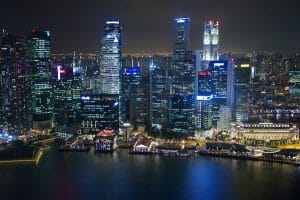Can You Afford To Take That Expat Job Offer?

Singapore retains its title as the world’s most expensive city for a fourth consecutive year in a top ten that may have a familiar feel to it. Not only has Singapore stayed top but Hong Kong remains second, closely followed by Zurich.
The latest survey of living costs by the Economist Intelligence Unit has also seen a return to the top ten most expensive cities for Tokyo and Osaka. The Japanese capital, which was the world’s most expensive city until 2012, has moved seven places up the ranking owing to a sustained recovery in the strength of the Japanese yen.
With Japanese cities returning to the fold, Asia now accounts for half of the ten most expensive cities ranked. Western Europe accounts for a further four cities, while New York City is the lone North American representative. The Big Apple, which rose to seventh place last year, has fallen to ninth owing to a slight weakening of the US dollar, which has also affected the position of other US cities. This, however, still represents a comparatively sharp increase in the relative cost of living compared with five years ago, when New York was ranked 46th.
With the strength of the US dollar moderating and the euro remaining relatively stable, currencies such as the Canadian dollar, the Australian dollar and the New Zealand dollar have appreciated in value. As a result, Sydney and Melbourne in Australia, and Wellington and Auckland in New Zealand all feature among the 20 most expensive cities.
Although the relative cost of living has fallen slightly in the Swiss cities of Zurich and Geneva, both remain cemented among the ten most expensive, in third place and joint seventh place respectively. Joining Geneva in seventh place is Paris, which has featured among the ten most expensive cities for 15 years, although the relative cost of living in the French capital has moderated. Currently, living in Paris is 7% more expensive than living in New York, but just five years ago it was 50% pricier.
Last year deflation and devaluations were prominent factors in determining the cost of living, with many cities falling down the ranking owing to currency weakness or falling local prices. Both prices and a number of currencies rallied during 2016 and, although inflation in many cities has remained moderate, the impact is reflected in the average cost of living.
Taking an average of the indices for all cities surveyed using New York as base city, the global cost of living has risen to 74%, up slightly from 73% last year. This remains significantly lower than five years ago when the average cost of living index across 132 cities was at an all-time high of 93.5%.
Despite topping the ranking, Singapore still offers relative value in some categories, especially compared with its regional peers. For categories such as personal care, household goods and domestic help, Singapore remains significantly cheaper than its peers, although it remains the most expensive place in the world to buy and run a car, as well as the second-priciest destination in which to buy clothes. In terms of food and drink the cost of living in Singapore is on a par with that of Shanghai in China.
Seoul, Tokyo and Osaka present the three most expensive places in the world to buy staple goods. In Seoul, topping up a grocery basket is almost 50% more expensive than in New York.
The Ten Most Expensive Cities In The World
[one_third]City
Singapore
Hong Kong
Zurich
Tokyo
Osaka
Seoul
Geneva
Paris
New York
Copenhagen[/one_third] [one_third]WCOL Index*
120
114
113
110
109
108
107
107
100
100[/one_third] [one_third_last]Rank
1
2
3
4
5
6
7=
7=
9=
9=[/one_third_last]
*Compares city costs to New York’s 100. So, Singapore is one-fifth more expensive than New York.
Source: Economist Intelligence Unit
With the dollar weakening slightly against other currencies, New York is the only North American city among the ten most expensive cities, although Los Angeles remains highly ranked, in 11th place. Although recent years have seen the relative cost of living in US cities rise, the latest ranking reflects a fall for all but two of the 16 cities surveyed.
Meanwhile, the rise in the relative cost of living in Seoul has continued. The South Korean capital, which was ranked as low as 50th just seven years ago, now occupies sixth place. Seoul’s rise contrasts with a fall among Chinese cities, where weakening consumption growth and a steady devaluation of the renminbi has resulted in China’s urban centres moving down the ranking by between five and 16 places each.
Paris is the only eurozone city among the ten most expensive. The French capital remains structurally extremely expensive to live in, with only alcohol and tobacco offering value for money compared with other European cities. The Danish capital, Copenhagen, which pegs its currency to the euro, also features in the ten priciest, largely owing to relatively high transport and personal care costs.
When looking at the most expensive cities by category, it is interesting to note that Asian cities tend to form the priciest locations for general grocery shopping. However, European cities tend to be priciest in the recreation and entertainment categories, with Zurich and Geneva the most expensive, perhaps reflecting a greater premium on discretionary spending